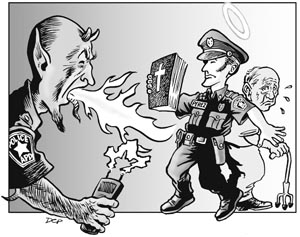former Orange County Sheriff’s Detective Ron Thomas after viewing the mangled
body of his 37-year-old son, Kelly. “A gang of rogue officers … brutally
beat my son to death.”
was murdered by a thugscrum of at least six police officers on a sidewalk in
Fullerton. Kelly, who had a criminal record, was a homeless adult who had been diagnosed with schizophrenia. On the evening of July 5, police were called to a
street near the Fullerton bus depot by a report that someone was burglarizing
parked cars.
with the police. He was tasered at least five times and beaten until brain-dead
while pleading with the officers and crying out for his father. Multiple
eyewitness accounts have disclosed that the beating continued – punctuated by
the familiar demand that the victim “stop resisting!” -- long after Kelly was
on his back, motionless and defenseless.
all proper respect to Ron Thomas, however, the grieving father is desperately
wrong about one detail: The murderers were not “rogue officers.” Once the gang
assault on Kelly began, practically the only thing that could have saved his life would have been the timely intervention of a rogue officer.
liberty, and property. That would be the role played by peace officers -- a population that is, for all intents and purposes, extinct. Police
are given the task of “enforcement” – the imposition of rules devised by, and
on behalf of, the wealth-devouring class. That role includes dispensing summary
punishment against people who display anything other than instant, unqualified
submission to them and to the political order they embody. Any material good
that is done by a police officer is a renegade act, given the nature and
purposes of the institution that employs him.
officer, that armed functionary’s first priority is not to “serve” or to
“protect” anybody. Sociologist James Q. Wilson, whose writings became somethingakin to canonical texts for Rudolph Giuliani and other politicians and policy
makers of an authoritarian bent, explains that a police officer’s first priority is to “impose authority on people who are unpredictable, apprehensive,
and often hostile.”
presence of an armed stranger of dubious character who demands unqualified
submission. The hostility is predictable, entirely defensible, and generally
commendable. Members of the Costumed Enforcer Class refer to it as “Contempt of Cop,” and regard it as an offense subject to summary punishment through the application of..., frequently of a lethal nature.
officer himself who teaches “arrest and control” techniques – explains that the
officers who murdered his son weren’t attempting to arrest him as a criminal
suspect, but rather “bullying” him “under color of authority” as punishment for
“contempt of cop.”
often justified resistance. He summons “backup,” and a thugscrum – which is a phenomenon
similar to a criminal “flash mob,” but generally more lethal – quickly coalesces and deals out hideous violence while terrified citizens look on in
horror and apparent helplessness.
Any officer who doesn’t play a hands-on role
in beating the “suspect” will devote his attention to “crowd control” – that
is, preventing intervention on behalf of the victim, and often confiscating any
recording devices that might be used to gather incriminating video of the
episode.
depends on a chain reaction of conformity, and often a single rogue element
would be sufficient to prevent it from reaching critical mass. A “rogue cop” –
that is, a peace officer devoted to protecting life, liberty, and property, rather
than a dutiful law enforcer determined to uphold “authority” – would interpose
on behalf of the victim.
round off that estimate to “never.” This is because “rogue” cops who commit such
renegade acts of lawfulness are never treated with the union-organized
solicitude displayed toward “good” cops who commit acts of criminal violence
against Mundanes.
Ramon Perez, who joined the force as a 41-year-old rookie cop because of a
sincere desire to protect people from crime. During a January 2005 domestic
violence incident, Perez refused an order by a superior officer, Robert
Paranich, to use his Taser on an elderly man who was not a threat to himself or
anybody else.
advanced years, Perez was understandably concerned that the portable
electro-shock torture device would kill him. Furthermore, using the Taser in
that situation would have violated the explicit provisions of the Austin PD’s
Taser Policy. Perez was able to resolve the situation through de-escalation,
rather than by using potentially lethal force to “impose authority.”
considered a punitive transfer to the night shift. Two months later, following
a second incident in which Perez chose de-escalation over armed compulsion, he
was invited to what he was told would be a “counseling” session with the APD’s
staff psychologist, Carol Logan. The purpose of that meeting, Perez was told,
was to help him develop better “communication skills” with his fellow officers.
In fact, it was a disguised “fit-for-duty review” convened to find a pretext to
purge the probationary officer from the force before the “rogue cop” could
infect others with his respect for individual rights.
Chronicle reported, Ms.
Logan’s four-page report focused “entirely on Perez's moral and religious
beliefs, which Logan concludes are so strong they are an `impairment' to his
ability to be a police officer.”
fundamentalist Christian, an ordained minister, and home-schooling parent, was
not as morally ductile as the typical police recruit. He saw protection of
civil liberties as the paramount duty of a police officer, an obligation he
viewed as a literal religious vocation. For this reason Perez was seen as
unsuitable for a ministry in the State’s punitive priesthood.
resign and retain his peace officer’s license, or be terminated and lose it.
This was done, once again, as punishment for Perez’s “rogue” conduct – which
consisted of his refusal to break the law and violate department policy.
Bowling on July 10, 2003, the one-time cement worker from Kansas City,
Kansas wouldn’t be a functional invalid at the age of 37. It was Bowling’s
life-changing misfortune that day to be involved
in a minor non-injury crash with an automobile carrying three undercover DEA
agents. In a fit of juvenile
impatience, the driver, DEA agent Timothy McCue, attempted to pass Bowling’s
car illegally on the right side of a single lane.
of his car with a drawn gun. With help from one of his fellow heroes, McCue forced
Bowling lie face-down on the pavement, despite the fact that the 98 degree heat
had turned it into a frying pan. When Bowling attempted to push himself up,
McCue began to punch and pistol-whip him while taunting his victim for
supposedly being an “inbred hillbilly” and “system-dodging white trash.” One
witness to the crime reported that McCue threatened to murder Bowling. With the
help of his comrades, McCue handcuffed the victim and continued to beat and
kick him after he was shackled and completely helpless.


